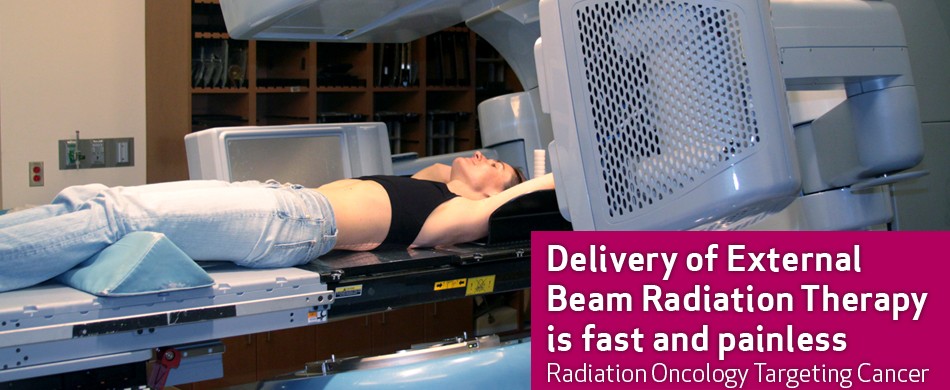External Beam Radiation Therapy (EBRT)


External Beam Radiation Therapy (EBRT) refers to the delivery of tightly targeted radiation beams from outside the body. A course of EBRT involves several daily treatments (fractions) over a few days to a few weeks. The radiation oncology team controls the radiation machine (usually a linear accelerator) to generate and direct the radiation beams. EBRT usually delivers X-rays (also called photons) but can also use electrons or other rarer particles such as protons. These have different properties which can be useful for different cancers or settings. The experience for the patient is similar to having an X-ray or CT scan – there is no sensation of being treated.
Conventional external beam radiation therapy (EBRT)
EBRT involves targeted radiation beams being delivered from outside the body. It is a non-invasive method of delivering radiation to a tumour. The radiation beams are shaped as they come out of the linear accelerator and/or before they reach the patient to make sure that they are carefully directed at the cancer.
Intensity-modulated radiation therapy (IMRT)
IMRT is a special form of EBRT involving the delivery of hundreds of small radiation beams with different intensities, entering the body from a number of different angles. This form of radiation therapy was first commonly used for prostate and head and neck cancers in Australia, but is now being used for many cancer sites. It is very precise, sometimes allowing higher doses to be given safely, without causing damage to the surrounding organs.
Image-guided radiation therapy (IGRT)
IGRT involves repeated imaging of the tumour during treatment. It is used in nearly all IMRT treatments to ensure accuracy to the millimetre. IGRT allows the treatment team to see small changes in tumour or organ shape, size and position, enabling the treatment team to make necessary adjustments to the radiation delivery during or between daily treatments. This ensures that the cancer cells remain targeted while reducing radiation exposure to healthy cells.
Stereotactic radiosurgery (SRS)
SRS is used to treat small tumours with well-defined edges. It is particularly useful for cancers in the brain or spine. In SRS treatments, a single high dose of radiation is delivered to the tumour with the assistance of highly accurate imaging and planning. A head frame is usually required for brain treatments to ensure the patient stays completely still.
Stereotactic body radiation therapy (SBRT)
SBRT delivers very high dose radiation focally to small tumours outside of the spine or brain. Immobilisation of the body is critical, although small movements that may affect the precise delivery of the treatment, such as breathing, are taken into account. For this reason, SBRT is usually given in several slightly lower dose treatments than SRS, across several sessions. Stereotactic radiation therapy may also be used for tumours in the brain or spinal cord, similar to SRS, but again using a few lower dose treatments rather than the one larger dose. This approach to treatment is still partially in a research phase but it is likely to become a bigger part of radiation oncology in the future.
Proton therapy
Particle therapy is an advanced form of radiation therapy that can be advantageous in specific cases. The most common form is called proton therapy and at this stage, Australian patients must travel overseas to access this treatment. Individuals who are most likely to benefit from proton therapy include those who have tumours that are near vital organs (such as base of skull tumours adjacent to the brainstem and nerves responsible for vision) and young patients where long term effects of treatment can potentially be minimised (such as hormonal imbalances, intellectual development delay and secondary cancers).
Useful Resources
The ‘Patient Pathway’ video below outlines the pathway that a patient will go through when being treated using radiation therapy (also called radiotherapy). This video shows the roles of each of the specialties in the radiation oncology team including radiation oncologists, radiation therapists and radiation oncology medical physicists.



